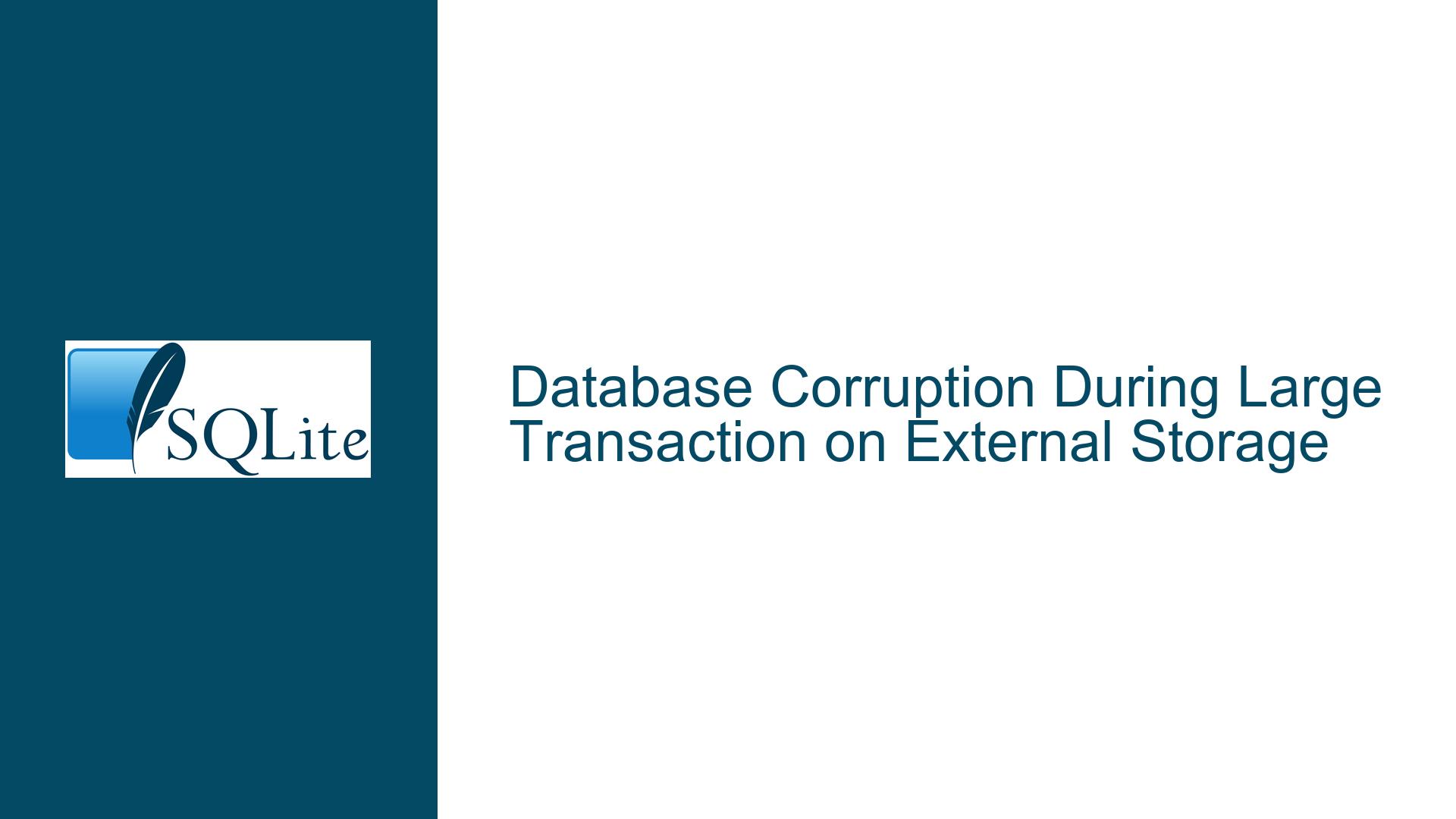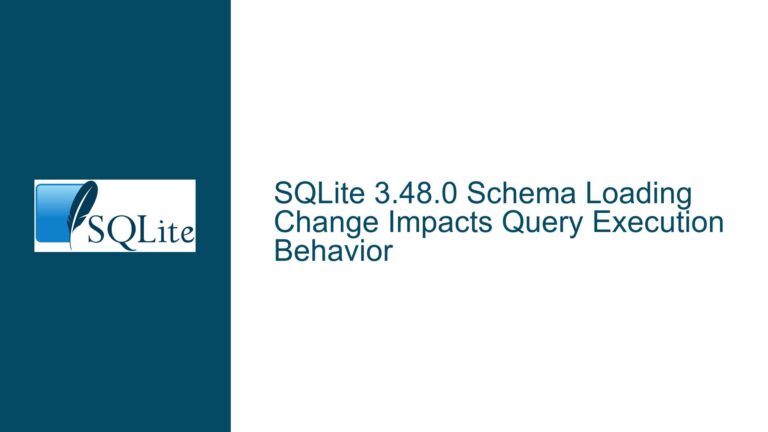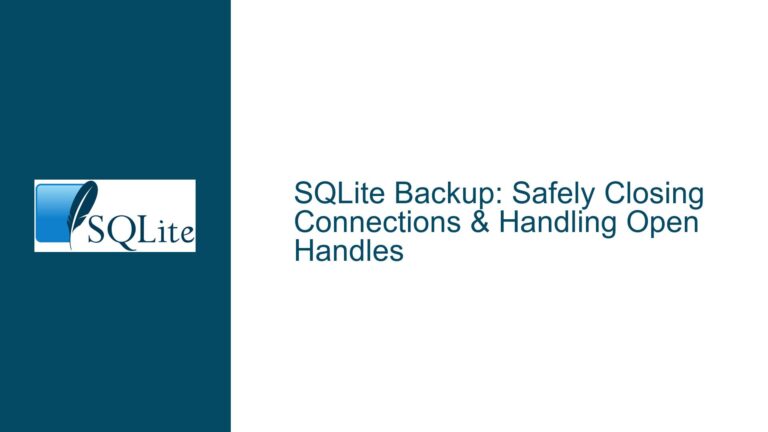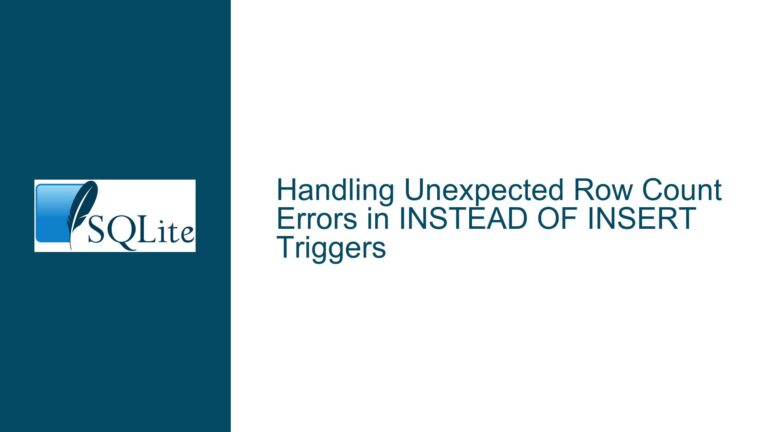Database Corruption During Large Transaction on External Storage
Issue Overview: Disk Image Corruption on Bulk Transaction with External SSD
The core issue revolves around a SQLite database becoming malformed ("disk image malformed") when executing a resource-intensive transaction involving a large dataset (260GB) stored on an external SSD. The transaction completes successfully on a small subset of data (e.g., LIMIT 1000) but fails catastrophically when applied to the full dataset. The corruption manifests after the transaction attempts to create a derived table via a complex SELECT statement with aggregations, subqueries, and string operations. Key symptoms include:
- No pre-existing corruption: The original database passes
PRAGMA integrity_check. - Hardware-specific failure: The issue disappears when the database is moved to an internal SSD.
- Intermittent write reliability: The external SSD (with 500GB free space) intermittently fails during sustained write operations despite being less than two years old.
This problem highlights the interplay between SQLite’s transactional guarantees and hardware reliability. SQLite assumes stable storage: if the underlying storage subsystem (e.g., external SSD) violates write atomicity or silently corrupts data, the database file becomes structurally unsound. The transaction in question involves creating a new table with aggregated data, which requires:
- Reading the entire
contribDBtable twice (once for the outer query, once for the subquery). - Writing a new table (
Contrib_census_date_recip) with grouped data. - Managing temporary files for sorting and intermediate results, which may exceed the external SSD’s ability to handle sustained I/O.
The absence of corruption in smaller datasets arises because the transaction duration and I/O load are insufficient to expose hardware flaws. With larger datasets, prolonged write activity magnifies latent issues in storage hardware, filesystem drivers, or connection interfaces (e.g., USB-C/USB-A controllers).
Possible Causes: Storage Subsystem Failures and Transactional Overhead
1. External Storage Hardware Limitations
External SSDs often use lower-grade NAND flash memory or controllers compared to internal drives. Sustained write operations (common in large transactions) generate heat, which can trigger thermal throttling or exacerbate pre-existing defects in flash cells. Unlike read-heavy workflows, write operations in SQLite involve:
- Journal file updates: In default rollback journal mode, SQLite writes changes to a journal before updating the main database.
- Temporary sorting files: Queries with
GROUP BYorORDER BYclauses generate temporary files proportional to the dataset size. - Checkpointing in WAL mode: If the database uses Write-Ahead Logging (WAL), checkpointing operations merge the WAL file into the main database, requiring sequential writes.
External SSDs may not handle these patterns reliably under heavy load, leading to partial writes or filesystem metadata corruption.
2. Filesystem or Driver Incompatilities
External drives are often formatted with filesystems optimized for portability (e.g., exFAT, FAT32) rather than transactional integrity. Key risks include:
- Lack of atomic rename operations: SQLite relies on atomic filesystem operations for commit/rollback. Non-atomic renames (common in FAT32) can leave the database in an inconsistent state.
- Incomplete write barriers: Filesystem drivers may delay or reorder writes for performance, violating SQLite’s assumption that writes are durable and ordered.
3. I/O Errors During Transaction Finalization
The CREATE TABLE ... AS SELECT (CTAS) operation involves two phases:
- Data processing: The query engine reads source data, computes aggregates, and sorts results.
- Table creation: SQLite writes the final result set to the new table and updates the schema in
sqlite_master.
If the external SSD encounters an I/O error during phase two, the database page headers or freelist may be left in an invalid state. SQLite’s error handling cannot recover from storage-layer corruption, as it assumes such errors are fatal.
4. Resource Exhaustion
Although the user reported 500GB free space, other resources may be strained:
- File descriptors: The R SQLite driver may leak handles during long-running queries.
- Memory-mapped I/O: SQLite’s memory mapping can consume excessive virtual address space on 32-bit systems.
- Interruptions in power/USB connectivity: External drives are prone to disconnections during long operations.
Troubleshooting Steps, Solutions & Fixes: Diagnosing and Mitigating Storage-Induced Corruption
Step 1: Confirm Hardware and Filesystem Integrity
- Test the external SSD with
f3(Fight Flash Fraud):f3 write /mount/point && f3 read /mount/pointThis detects counterfeit drives and failing flash blocks. A healthy SSD should show zero errors.
- Reformat the drive with a journaled filesystem: Use NTFS (Windows), APFS (macOS), or ext4 (Linux) with journaling enabled. Avoid exFAT/FAT32.
- Monitor SMART attributes: Tools like
smartctl(Linux) or CrystalDiskInfo (Windows) reveal reallocated sectors, wear leveling counts, and pending errors.
Step 2: Isolate the SQLite Environment
- Reproduce the issue using the SQLite CLI:
sqlite3 contrib.db < query.sqlBypassing the R interface eliminates driver-specific bugs.
- Enable SQLite’s I/O error logging:
.log stderr PRAGMA vdbe_trace = 1;This logs low-level I/O events, helping identify whether errors occur during journal writes or page commits.
Step 3: Optimize the Query for Reduced I/O Pressure
The original query has several inefficiencies exacerbating I/O load:
- Redundant subquery: The
IN (SELECT ...)clause forces a full table scan ofcontribDBtwice. Replace with aJOIN:CREATE TABLE Contrib_census_date_recip AS SELECT date, censustract, recipient_party, bonica_rid, recipient_name, SUBSTR(date,1,4) AS Year, SUBSTR(date,6,2) AS Month, SUBSTR(date,9,2) AS Day, SUM(amount) AS Donation_sum, COUNT(amount) AS Donation_number FROM contribDB AS outer INNER JOIN ( SELECT transaction_id FROM contribDB WHERE cycle >= 2014 AND bk_ref_transaction_id = '' AND contributor_type = 'I' AND recipient_party != '' AND date != '' AND censustract != '' AND amount >= 0 ) AS sub USING (transaction_id) WHERE (SUBSTR(outer.date, 1, 4) BETWEEN '2015' AND '2023') GROUP BY censustract, date, bonica_rid; - Precompute date components: Store year/month/day as generated columns in
contribDBto avoid repetitiveSUBSTRcalls. - Increase memory limits:
PRAGMA cache_size = -1000000; -- 1GB cache PRAGMA temp_store = MEMORY; -- Keep temp tables in RAM
Step 4: Use Conservative Transactional Settings
- Disable memory-mapped I/O:
PRAGMA mmap_size = 0;Prevents virtual memory subsystem interactions from compounding storage errors.
- Enable WAL mode with cautious checkpointing:
PRAGMA journal_mode = WAL; PRAGMA wal_autocheckpoint = 1000; -- Checkpoint every 1000 pagesWAL reduces disk contention but requires monitoring for checkpoint stalls.
Step 5: Implement Robust Error Handling and Validation
- Wrap the transaction in a SAVEPOINT:
BEGIN; SAVEPOINT sp1; -- Run CTAS query here RELEASE sp1; COMMIT;If corruption occurs, roll back to
sp1and retry. - Validate the new table immediately after creation:
PRAGMA quick_check; SELECT COUNT(*) FROM Contrib_census_date_recip;
Step 6: Migrate to Internal Storage or Enterprise-Grade Hardware
If the external SSD consistently fails:
- Use internal storage for active databases: Even if smaller, internal SSDs have higher endurance and better thermal management.
- Invest in a UPS: Prevents power-related corruption during write operations.
- Consider RAID-1 mirroring: Provides redundancy against sector failures.
Step 7: Salvage Corrupted Databases
If corruption occurs:
- Dump and reload:
sqlite3 corrupted.db .dump | sqlite3 new.dbBypasses damaged pages by exporting SQL text.
- Use
.recover:sqlite3 corrupted.db ".recover" | sqlite3 recovered.dbExtracts data from corrupt tables, skipping invalid pages.
By systematically addressing storage reliability, query efficiency, and SQLite configuration, users can mitigate the risk of database corruption during large transactions. Hardware failures remain the most insidious cause, necessitating rigorous validation of storage subsystems before deploying them in data-intensive workflows.






